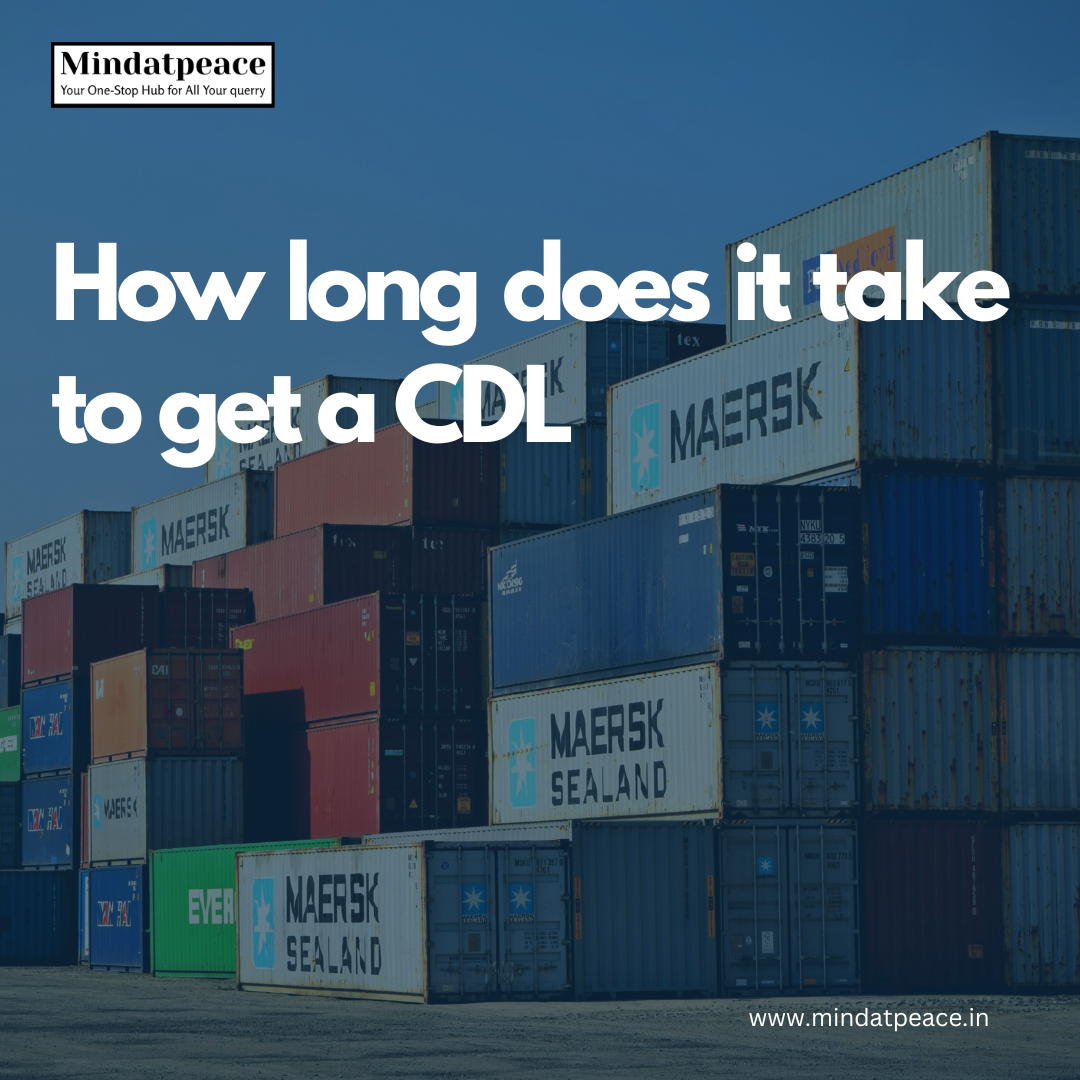How long does it take to get a CDL is a common question among individuals considering a career in commercial driving. The time it takes varies depending on factors such as completing CDL training programs, passing written and skills tests, and navigating the application process. Generally, CDL training programs can last anywhere from a few weeks to several months, depending on availability and program structure. Additionally, scheduling for tests and processing times at the Department of Motor Vehicles (DMV) or licensing agency can affect the overall timeline. Thus, while the process typically ranges from a few weeks to a few months, individual circumstances may vary.
CDL Requirements
Age and Citizenship: Applicants must be at least 21 years old for interstate driving and 18 years old for intrastate driving. They must also be U.S. citizens or legal residents.
Medical Requirements: Drivers must pass a medical examination conducted by a certified medical examiner to meet the standards set by the Federal Motor Carrier Safety Administration (FMCSA).
Educational Qualifications: While there are no formal education requirements, applicants must be able to read and speak English proficiently. Some employers may require a high school diploma or equivalent.
CDL Training Programs
Classroom Instruction: Students receive theoretical knowledge about commercial driving regulations, safety procedures, and vehicle operations through classroom sessions.
Behind-the-Wheel Training: Hands-on training allows students to develop practical skills in operating commercial vehicles. They learn essential maneuvers, handling techniques, and safety protocols under the guidance of experienced instructors.
Duration of Training: The duration of CDL training programs can vary depending on the specific program and the student’s schedule. Programs may range from a few weeks to several months, offering flexible options to accommodate different learning needs.
Written CDL Exam
The written CDL exam is a crucial step in obtaining a Commercial Driver’s License (CDL) in the United States. This exam assesses an applicant’s knowledge of commercial driving regulations, safety practices, and vehicle operations. Key aspects of the written CDL exam include:
Topics Covered: The exam covers various topics relevant to commercial driving, including traffic laws, vehicle inspection procedures, hazardous materials regulations, and safe driving practices.
Study Resources: Applicants can prepare for the written CDL exam using a variety of study resources, including official CDL manuals provided by state Departments of Motor Vehicles (DMVs), online practice tests, and study guides.
Tips for Success: Success on the written CDL exam requires diligent study and preparation. Applicants should review the CDL manual thoroughly, focus on understanding key concepts and regulations, and practice answering sample questions to familiarize themselves with the exam format.
CDL Skills Test
The skills test is the practical aspect of acquiring a CDL. Divided into pre-trip inspection, basic control skills, and on-road driving, this examination assesses an applicant’s ability to operate a commercial vehicle safely and efficiently.
Application Process
DMV Requirements: Applicants must visit their local Department of Motor Vehicles (DMV) office to initiate the CDL application process. Each state may have specific requirements and procedures, so it’s essential to research and understand the regulations in the applicant’s state of residence.
Necessary Documents: Applicants need to provide various documents to support their CDL application. These documents typically include proof of identity, such as a valid driver’s license or passport, proof of residency, Social Security number, and any required medical certificates.
Application Forms: Applicants must complete the necessary application forms provided by the DMV. These forms gather essential information about the applicant, including personal details, driving history, and the type of CDL and endorsements sought.
Application Fees: There are fees associated with the CDL application process, including fees for the application itself, written and skills tests, and any endorsements requested. Applicants should be prepared to pay these fees at the time of application.
Written and Skills Tests: Before receiving a CDL, applicants must pass both a written knowledge test and a skills test. The written test assesses knowledge of commercial driving regulations and safety practices, while the skills test evaluates practical driving abilities.
Endorsements: Depending on the type of commercial driving activities an individual intends to pursue, additional endorsements may be required. These endorsements may involve additional testing and certification beyond the standard CDL requirements.
Processing Time
The processing time for obtaining a Commercial Driver’s License (CDL) varies depending on factors such as the state of application and the efficiency of the Department of Motor Vehicles (DMV) or licensing agency. Different states may have different processing times due to variations in administrative procedures and application volumes. Factors like the number of applications received, seasonal fluctuations, and the effectiveness of administrative systems can influence processing times. Applicants should be prepared for potential delays and may need to check with their local DMV or licensing agency for specific information regarding current processing times. Despite potential variations, staying informed and patient throughout the application process can help individuals navigate the CDL application process smoothly.
Waiting Periods
Waiting periods are a common aspect of the process for obtaining a Commercial Driver’s License (CDL) in the United States. These waiting periods can occur at various stages of the CDL acquisition journey. After completing training programs and before scheduling examinations, there may be a waiting period to secure a testing appointment. Additionally, between the written and skills tests, applicants may encounter a brief waiting period while the necessary arrangements are made. Furthermore, after submitting the CDL application, there may be a waiting period before receiving approval and the physical CDL card. These waiting periods are inherent to the process and allow for the efficient coordination of resources and scheduling. Aspiring drivers should be aware of these waiting periods and plan accordingly to minimize any disruptions to their CDL journey.
CDL Endorsements
CDL endorsements are additional certifications that drivers can obtain to expand their driving privileges and job opportunities within the commercial transportation industry. These endorsements signify specialized skills and qualifications beyond the basic requirements of a Commercial Driver’s License (CDL). To obtain endorsements, drivers must undergo additional training and pass specific tests related to the endorsement category. Common CDL endorsements include:
Hazmat (H): Allows drivers to transport hazardous materials, requiring knowledge of regulations and safety protocols for handling such materials.
Tanker (N): Permits drivers to transport liquids in tank vehicles, necessitating expertise in load securement and vehicle control.
Passenger (P): Enables drivers to transport passengers, such as in buses or other passenger vehicles, requiring skills in passenger safety and customer service.
Double/Triple Trailers (T): Allows drivers to operate vehicles pulling multiple trailers simultaneously, necessitating advanced maneuvering and coupling skills.
School Bus (S): Permits drivers to operate school buses, requiring knowledge of student transportation regulations and safety procedures.
Job Opportunities
Job opportunities for individuals with a Commercial Driver’s License (CDL) are abundant and diverse, offering a wide range of career paths within the transportation industry. CDL holders are in high demand across various sectors, including:
Trucking: Truck driving remains one of the most common career paths for commercial driving license holders. Truck drivers transport goods and materials over short and long distances, contributing to the supply chain and logistics industry.
Public Transportation: CDL holders can pursue careers in public transportation, such as driving city buses, school buses, or commuter buses. These roles play a vital role in transporting passengers safely and efficiently within communities.
Delivery Services: Many delivery services, including parcel delivery companies and courier services, require commercial driving license holders to operate delivery trucks and vans. These drivers ensure timely and accurate delivery of goods to customers and businesses.
Construction and Heavy Equipment: CDL holders may find opportunities in construction and heavy equipment operation. They operate vehicles such as dump trucks, cement mixers, and cranes, contributing to construction projects and infrastructure development.
Specialized Transportation: Some CDL holders specialize in niche areas such as hauling oversized loads, transporting hazardous materials, or driving refrigerated trucks for perishable goods.
Intermodal Transportation: commercial driving license holders can work in intermodal transportation, involving the movement of freight containers between different modes of transportation, such as trucks, trains, and ships.
Challenges and Solutions
Challenges and solutions in obtaining a Commercial Driver’s License (CDL) involve:
Test Preparation: Studying and practicing for written and skills tests.
Application Process: Navigating paperwork and requirements efficiently.
Test Anxiety: Managing stress through relaxation techniques and support.
Driving Conditions: Adapting to various road and weather conditions.
Regulatory Compliance: Staying informed and organized to meet regulations effectively.
Conclusion
In conclusion, the journey to obtain a commercial driving license in the USA is a multifaceted process. From meeting requirements and undergoing training to facing exams and navigating application processes, each step contributes to the overall timeline. However, the reward lies in a fulfilling career with endless possibilities in the transportation industry. Aspiring drivers should embrace the journey, knowing that each step brings them closer to achieving their goals and contributing to this vital sector of the economy. For more information and support along your commercial driving license journey, visit Mindatpeace, where we provide resources and guidance to help you succeed.
FAQs
Q. How long does CDL training typically last?
A. CDL training duration varies but often ranges from a few weeks to several months, depending on the program.
Q. Are there age restrictions for obtaining a CDL?
A. Yes, the minimum age requirement for obtaining a CDL in the USA is typically 21 for interstate driving and 18 for intrastate driving.
Q. What are the common challenges faced during the CDL application process?
A. Challenges may include gathering necessary documents, understanding state-specific requirements, and navigating administrative procedures.
Q. Can I apply for specific endorsements after obtaining a basic CDL?
A. Yes, individuals can apply for additional endorsements, such as hazardous materials or passenger transport, after obtaining a basic CDL.
Q. Is it possible to retake the commercial driving license exams if I fail initially?
A. Yes, most states allow applicants to retake the CDL exams after a waiting period. It’s essential to address areas of difficulty before reattempting.




